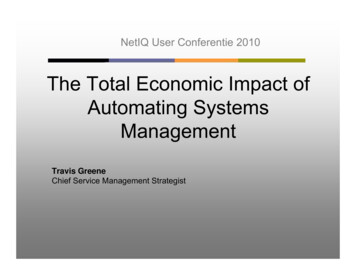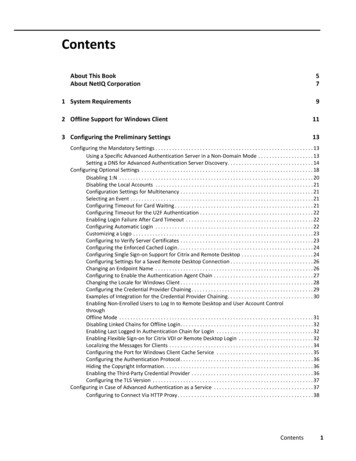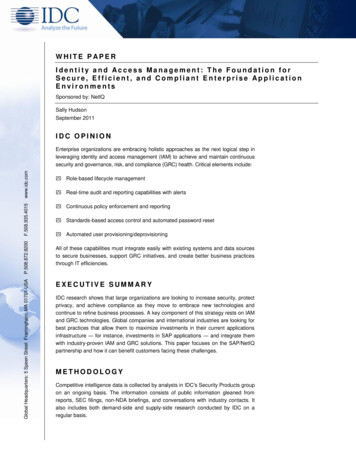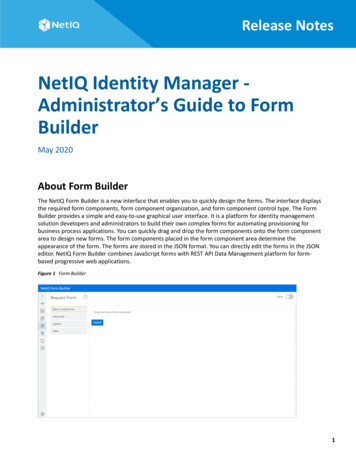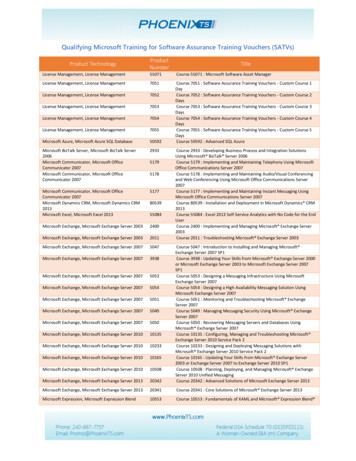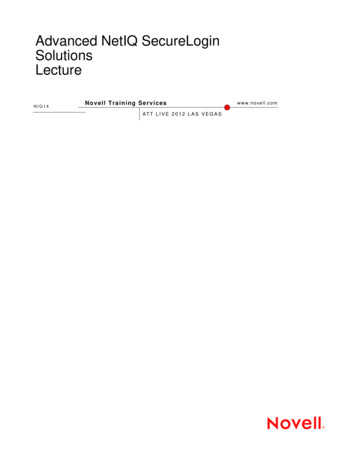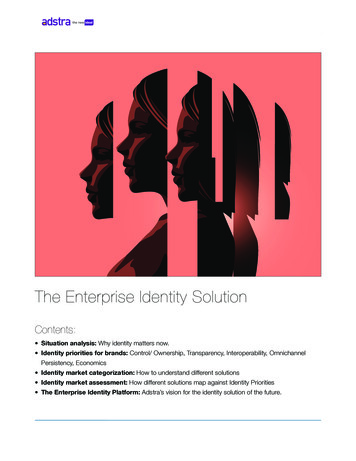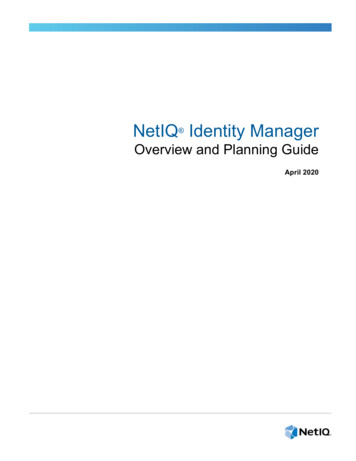
Transcription
NetIQ Identity ManagerOverview and Planning GuideApril 2020
Legal NoticeFor information about NetIQ legal notices, disclaimers, warranties, export and other use restrictions, U.S. Governmentrestricted rights, patent policy, and FIPS compliance, see https://www.netiq.com/company/legal/.Copyright (C) 2020 NetIQ Corporation. All rights reserved.
ContentsAbout this Book and the LibraryAbout NetIQ Corporation79Part I Identity Manager Overview111 How Identity Manager Solves Business Challenges13Synchronizing Identity Information . . . . . . . . . . . . . . . . . . . . . . . . . . . . . . . . . . . . . . . . . . . . . . . . . . . . . . . . 14Automating Business and IT Processes with Workflows . . . . . . . . . . . . . . . . . . . . . . . . . . . . . . . . . . . . . . . 15. . . . . . . . . . . . . . . . . . . . . . . . . . . . . . . . . . . . . . . . . . . . . . . . . . . . . . . . . . . . . . . . . . . . . . . . . . . . . ProvidingRole-BasedAccess toUsers. . . . . . . . . . . . . . . . . . . . . . . . . . . . . . . . . . . . . . . . . . . . . . . . . . . . . . . . . . . . . . . . . . . . . . . . . . . . . . . 17Enabling Self-Service for Users . . . . . . . . . . . . . . . . . . . . . . . . . . . . . . . . . . . . . . . . . . . . . . . . . . . . . . . . . . 17Auditing, Reporting, and Complying with Regulations . . . . . . . . . . . . . . . . . . . . . . . . . . . . . . . . . . . . . . . . . 182 Identity Manager Editions213 Identity Manager Architecture23How Identity Manager Works . . . . . . . . . . . . . . . . . . . . . . . . . . . . . . . . . . . . . . . . . . . . . . . . . . . . . . . . . . . . 24Identity Vault. . . . . . . . . . . . . . . . . . . . . . . . . . . . . . . . . . . . . . . . . . . . . . . . . . . . . . . . . . . . . . . . . . . . 24Identity Manager Engine . . . . . . . . . . . . . . . . . . . . . . . . . . . . . . . . . . . . . . . . . . . . . . . . . . . . . . . . . . 24Remote Loader . . . . . . . . . . . . . . . . . . . . . . . . . . . . . . . . . . . . . . . . . . . . . . . . . . . . . . . . . . . . . . . . . 25Connected System . . . . . . . . . . . . . . . . . . . . . . . . . . . . . . . . . . . . . . . . . . . . . . . . . . . . . . . . . . . . . . . 25Identity Manager Driver . . . . . . . . . . . . . . . . . . . . . . . . . . . . . . . . . . . . . . . . . . . . . . . . . . . . . . . . . . . 25Identity Manager Driver Set . . . . . . . . . . . . . . . . . . . . . . . . . . . . . . . . . . . . . . . . . . . . . . . . . . . . . . . . 25Identity Reporting . . . . . . . . . . . . . . . . . . . . . . . . . . . . . . . . . . . . . . . . . . . . . . . . . . . . . . . . . . . . . . . . 26Identity Applications . . . . . . . . . . . . . . . . . . . . . . . . . . . . . . . . . . . . . . . . . . . . . . . . . . . . . . . . . . . . . 26Designer for Identity Manager . . . . . . . . . . . . . . . . . . . . . . . . . . . . . . . . . . . . . . . . . . . . . . . . . . . . . . 27Analyzer for Identity Manager . . . . . . . . . . . . . . . . . . . . . . . . . . . . . . . . . . . . . . . . . . . . . . . . . . . . . . 28iManager . . . . . . . . . . . . . . . . . . . . . . . . . . . . . . . . . . . . . . . . . . . . . . . . . . . . . . . . . . . . . . . . . . . . . . 28Key Features and Benefits of Architecture . . . . . . . . . . . . . . . . . . . . . . . . . . . . . . . . . . . . . . . . . . . . . . . . . . 28Staged Deployment . . . . . . . . . . . . . . . . . . . . . . . . . . . . . . . . . . . . . . . . . . . . . . . . . . . . . . . . . . . . . . 28Flexibility and Extensibility . . . . . . . . . . . . . . . . . . . . . . . . . . . . . . . . . . . . . . . . . . . . . . . . . . . . . . . . . 30Reuse of Existing Infrastructure . . . . . . . . . . . . . . . . . . . . . . . . . . . . . . . . . . . . . . . . . . . . . . . . . . . . 30Extensive Identity Integration . . . . . . . . . . . . . . . . . . . . . . . . . . . . . . . . . . . . . . . . . . . . . . . . . . . . . . . 30Built-in Audit and Compliance . . . . . . . . . . . . . . . . . . . . . . . . . . . . . . . . . . . . . . . . . . . . . . . . . . . . . . 314 Identity Manager Integration Solutions with Existing IT Infrastructure andApplications33Out-of-Box Drivers . . . . . . . . . . . . . . . . . . . . . . . . . . . . . . . . . . . . . . . . . . . . . . . . . . . . . . . . . . . . . . . . . . . . 33Identity Manager Driver Development Kit . . . . . . . . . . . . . . . . . . . . . . . . . . . . . . . . . . . . . . . . . . . . . . . . . . . 33SOAP and REST API Support for Identity Applications . . . . . . . . . . . . . . . . . . . . . . . . . . . . . . . . . . . . . . . . 345 Identity Manager Deployment Configurations35Basic Configuration. . . . . . . . . . . . . . . . . . . . . . . . . . . . . . . . . . . . . . . . . . . . . . . . . . . . . . . . . . . . . . . . . . . . 35Contents3
High Availability Configuration . . . . . . . . . . . . . . . . . . . . . . . . . . . . . . . . . . . . . . . . . . . . . . . . . . . . . . . . . . . 376 Understanding Identity Manager Localization39Translated Components and Installation Programs . . . . . . . . . . . . . . . . . . . . . . . . . . . . . . . . . . . . . . . . . . . 39Special Considerations for Language Support . . . . . . . . . . . . . . . . . . . . . . . . . . . . . . . . . . . . . . . . . . . . . . . 407 Where to Get Identity Manager418 Understanding Licensing and Activation45Activating Identity Manager. . . . . . . . . . . . . . . . . . . . . . . . . . . . . . . . . . . . . . . . . . . . . . . . . . . . . . . . . . . . . . 45Installing a Product Activation Credential . . . . . . . . . . . . . . . . . . . . . . . . . . . . . . . . . . . . . . . . . . . . . . 45Reviewing Product Activations for Identity Manager and Drivers. . . . . . . . . . . . . . . . . . . . . . . . . . . . 46Activating Identity Manager Drivers . . . . . . . . . . . . . . . . . . . . . . . . . . . . . . . . . . . . . . . . . . . . . . . . . . 47Activating Specific Identity Manager Components . . . . . . . . . . . . . . . . . . . . . . . . . . . . . . . . . . . . . . . 47Part II Planning519 Creating a Project Plan53Discovery Phase . . . . . . . . . . . . . . . . . . . . . . . . . . . . . . . . . . . . . . . . . . . . . . . . . . . . . . . . . . . . . . . . . . . . . . 53Discovering Current Business Processes . . . . . . . . . . . . . . . . . . . . . . . . . . . . . . . . . . . . . . . . . . . . . 54Defining How the Identity Manager Solution Affects the Current Business Processes . . . . . . . . . . . 55Identifying the Key Business and Technical Stakeholders . . . . . . . . . . . . . . . . . . . . . . . . . . . . . . . . . 56Interviewing All Stakeholders . . . . . . . . . . . . . . . . . . . . . . . . . . . . . . . . . . . . . . . . . . . . . . . . . . . . . . . 56Creating a High-level Strategy and an Agreed Execution Path . . . . . . . . . . . . . . . . . . . . . . . . . . . . . 56Requirements and Design Analysis Phase . . . . . . . . . . . . . . . . . . . . . . . . . . . . . . . . . . . . . . . . . . . . . . . . . . 57Defining the Business Requirements . . . . . . . . . . . . . . . . . . . . . . . . . . . . . . . . . . . . . . . . . . . . . . . . . 58Analyzing Your Business Processes . . . . . . . . . . . . . . . . . . . . . . . . . . . . . . . . . . . . . . . . . . . . . . . . . 59Designing an Enterprise Data Model . . . . . . . . . . . . . . . . . . . . . . . . . . . . . . . . . . . . . . . . . . . . . . . . . 59Proof of Concept . . . . . . . . . . . . . . . . . . . . . . . . . . . . . . . . . . . . . . . . . . . . . . . . . . . . . . . . . . . . . . . . . . . . . . 61Data Validation and Preparation . . . . . . . . . . . . . . . . . . . . . . . . . . . . . . . . . . . . . . . . . . . . . . . . . . . . . . . . . . 61Quality Assurance . . . . . . . . . . . . . . . . . . . . . . . . . . . . . . . . . . . . . . . . . . . . . . . . . . . . . . . . . . . . . . . . . . . . . 61Production Roll-out Planning . . . . . . . . . . . . . . . . . . . . . . . . . . . . . . . . . . . . . . . . . . . . . . . . . . . . . . . . . . . . 62Production Deployment. . . . . . . . . . . . . . . . . . . . . . . . . . . . . . . . . . . . . . . . . . . . . . . . . . . . . . . . . . . . . . . . . 6210 Setting Up a Development Environment6311 Technical Guidelines65Components to Install . . . . . . . . . . . . . . . . . . . . . . . . . . . . . . . . . . . . . . . . . . . . . . . . . . . . . . . . . . . . . . . . . . 65Identity Manager Configurations . . . . . . . . . . . . . . . . . . . . . . . . . . . . . . . . . . . . . . . . . . . . . . . . . . . . . . . . . 65Technical Guidelines . . . . . . . . . . . . . . . . . . . . . . . . . . . . . . . . . . . . . . . . . . . . . . . . . . . . . . . . . . . . . . . . . . . 65Management Tools Guidelines . . . . . . . . . . . . . . . . . . . . . . . . . . . . . . . . . . . . . . . . . . . . . . . . . . . . . . . . . . . 66Analyzer Guidelines . . . . . . . . . . . . . . . . . . . . . . . . . . . . . . . . . . . . . . . . . . . . . . . . . . . . . . . . . . . . . . 67Designer Guidelines . . . . . . . . . . . . . . . . . . . . . . . . . . . . . . . . . . . . . . . . . . . . . . . . . . . . . . . . . . . . . . 67iManager Guidelines . . . . . . . . . . . . . . . . . . . . . . . . . . . . . . . . . . . . . . . . . . . . . . . . . . . . . . . . . . . . . 68Identity Manager Server Guidelines . . . . . . . . . . . . . . . . . . . . . . . . . . . . . . . . . . . . . . . . . . . . . . . . . . . . . . . 68Considerations for Installing Drivers with the Identity Manager Engine . . . . . . . . . . . . . . . . . . . . . . . 68Considerations for Installing Drivers with the Remote Loader . . . . . . . . . . . . . . . . . . . . . . . . . . . . . . 68Identity Vault Guidelines . . . . . . . . . . . . . . . . . . . . . . . . . . . . . . . . . . . . . . . . . . . . . . . . . . . . . . . . . . . . . . . . 69Understanding Identity Manager Objects in Identity Vault . . . . . . . . . . . . . . . . . . . . . . . . . . . . . . . . . 70Replicating the Objects that Identity Manager Needs on the Server . . . . . . . . . . . . . . . . . . . . . . . . . 70Using Scope Filtering to Manage Users on Different Servers . . . . . . . . . . . . . . . . . . . . . . . . . . . . . . 714Contents
Improving Identity Vault Performance . . . . . . . . . . . . . . . . . . . . . . . . . . . . . . . . . . . . . . . . . . . . . . . . 73Identity Applications Guidelines . . . . . . . . . . . . . . . . . . . . . . . . . . . . . . . . . . . . . . . . . . . . . . . . . . . . . . . . . . 73Auditing and Reporting Guidelines . . . . . . . . . . . . . . . . . . . . . . . . . . . . . . . . . . . . . . . . . . . . . . . . . . . . . . . . 75Contents5
6
About this Book and the LibraryThis guide introduces you to NetIQ Identity Manager, a WorkloadIQ product that manages identityand access across physical, virtual, and cloud environments. This guide explains business issuesthat Identity Manager can help you solve while reducing costs and ensuring compliance. It alsocontains a technical overview of the Identity Manager components and tools you can use to createyour Identity Manager solution.Intended AudienceThis guide is intended for administrators, consultants, and network engineers who require a high-levelintroduction to Identity Manager business solutions, technologies, and tools.Other Information in the LibraryFor more information about the library for Identity Manager, see the Identity Manager documentationwebsite.About this Book and the Library7
8About this Book and the Library
About NetIQ CorporationWe are a global, enterprise software company, with a focus on the three persistent challenges in yourenvironment: Change, complexity and risk—and how we can help you control them.Our ViewpointAdapting to change and managing complexity and risk are nothing newIn fact, of all the challenges you face, these are perhaps the most prominent variables that denyyou the control you need to securely measure, monitor, and manage your physical, virtual, andcloud computing environments.Enabling critical business services, better and fasterWe believe that providing as much control as possible to IT organizations is the only way toenable timelier and cost effective delivery of services. Persistent pressures like change andcomplexity will only continue to increase as organizations continue to change and thetechnologies needed to manage them become inherently more complex.Our PhilosophySelling intelligent solutions, not just softwareIn order to provide reliable control, we first make sure we understand the real-world scenarios inwhich IT organizations like yours operate—day in and day out. That's the only way we candevelop practical, intelligent IT solutions that successfully yield proven, measurable results. Andthat's so much more rewarding than simply selling software.Driving your success is our passionWe place your success at the heart of how we do business. From product inception todeployment, we understand that you need IT solutions that work well and integrate seamlesslywith your existing investments; you need ongoing support and training post-deployment; and youneed someone that is truly easy to work with—for a change. Ultimately, when you succeed, weall succeed.Our Solutions Identity & Access Governance Access Management Security Management Systems & Application Management Workload Management Service ManagementAbout NetIQ Corporation9
Contacting Sales SupportFor questions about products, pricing, and capabilities, contact your local partner. If you cannotcontact your partner, contact our Sales Support team.Worldwide:www.netiq.com/about netiq/officelocations.aspUnited States and ww.netiq.comContacting Technical SupportFor specific product issues, contact our Technical Support spNorth and South America:1-713-418-5555Europe, Middle East, and Africa: 353 (0) 91-782 pportContacting Documentation SupportOur goal is to provide documentation that meets your needs. The documentation for this product isavailable on the NetIQ website in HTML and PDF formats on a page that does not require you to login. If you have suggestions for documentation improvements, click comment on this topic at thebottom of any page in the HTML version of the documentation posted at www.netiq.com/documentation. You can also email Documentation-Feedback@netiq.com. We value your input andlook forward to hearing from you.Contacting the Online User CommunityNetIQ Communities, the NetIQ online community, is a collaborative network connecting you to yourpeers and NetIQ experts. By providing more immediate information, useful links to helpful resources,and access to NetIQ experts, NetIQ Communities helps ensure you are mastering the knowledge youneed to realize the full potential of IT investments upon which you rely. For more information, visithttps://www.netiq.com/communities/.10About NetIQ Corporation
IIdentity Manager OverviewINetIQ Identity Manager is an end-to-end identity administration and user provisioning solution. Ithelps you build a secure and intelligent identity environment. Identity Manager includes enterprisewide access control, password management, and self-service functionalities. These capabilities helpyour organization to manage identities and resources efficiently. Identity Manager also improvesproductivity, mitigate risks, reduce administration cost and support regulatory compliance efforts.Identity Manager provides policy-driven access control to resources from the data center to the cloud,and also helps you ensure risk management and compliance. Chapter 1, “How Identity Manager Solves Business Challenges,” on page 13 Chapter 2, “Identity Manager Editions,” on page 21 Chapter 3, “Identity Manager Architecture,” on page 23 Chapter 4, “Identity Manager Integration Solutions with Existing IT Infrastructure andApplications,” on page 33 Chapter 5, “Identity Manager Deployment Configurations,” on page 35 Chapter 6, “Understanding Identity Manager Localization,” on page 39 Chapter 7, “Where to Get Identity Manager,” on page 41 Chapter 8, “Understanding Licensing and Activation,” on page 45Identity Manager Overview11
12Identity Manager Overview
1How Identity Manager Solves BusinessChallenges1Most organizations have their identity data stored on multiple systems. In this case, managingidentities and monitoring user activity on physical and virtual environments is important. IdentityManager solution provides an automated environment to solve these challenges by: Synchronizing the identity data across connected systems. Ensuring that users have access only to the resources required for their jobs. Provisioning or deprovisioning user access based on their roles. Providing compliance with your business policies and other regulatory requirementsThe following sections explain the features of Identity Manager that provides a solution for thesechallenges: “Synchronizing Identity Information” on page 14 “Automating Business and IT Processes with Workflows” on page 15 “Providing Role-Based Access to Users” on page 17 “Enabling Self-Service for Users” on page 17 “Auditing, Reporting, and Complying with Regulations” on page 18How Identity Manager Solves Business Challenges13
Synchronizing Identity InformationIdentity Manager lets you synchronize, transform, and share information across a wide range ofconnected systems, such as SAP, PeopleSoft, Microsoft SharePoint, Lotus Notes, MicrosoftExchange, Microsoft Active Directory, NetIQ eDirectory, Oracle, among many others. Figure 1-1represents how Identity Manager synchronizes information with multiple systems.Figure 1-1 Identity Manager Connecting Multiple SystemsPeopleSo SAPNetIQeDirectoryLotus NotesIden tyManagerMicroso ExchangeLinuxLDAPDirectoryMicroso Ac veDirectoryIdentity Manager lets you do the following activities: Control the flow of data among the connected systems. Determine what data is shared, which system is the authoritative source for a piece of data, andhow the data is interpreted and transformed to meet the requirements of other systems.In the following diagram, the Lotus Notes system is the authoritative source for a user’s e-mailaddress. The SAP HR database also uses e-mail addresses, so Identity Manager transforms thee-mail address into the required format and shares it with the SAP HR database. When the email address changes in the Lotus Notes system, it is synchronized to the SAP HR database.Lotus Notes(Authorita veSource)Iden tyManagerSAPHR DatabaseIf an administrator of the SAP HR database changes a user’s e-mail address in that system, thechange has no effect because the change must be made to the Lotus Notes system to beeffective. Identity Manager uses filters to specify authoritative sources for an item.14How Identity Manager Solves Business Challenges
Synchronize passwords between systems. For example, if a user changes his or her passwordin Active Directory, Identity Manager can synchronize that password to other connectedsystems. For example, Lotus Notes, SAP, or Oracle. Create new user accounts and remove existing accounts in connected systems. For example,when you hire a new employee in the SAP HR application, Identity Manager can automaticallycreate a new user account in other connected systems.Figure 1-2 User Account Creation in Connected SystemsUser ASAPIden tyManagerLinuxLotus NotesAc veDirectoryUser AUser AUser AAutomating Business and IT Processes withWorkflowsIn an organization, users often require access to various resources to accomplish tasks based ontheir roles. Identity Manager provides workflow capabilities to ensure that your provisioningprocesses involve the appropriate resource approvers.How Identity Manager Solves Business Challenges15
Manager(Reviewer 2)ApprovedApprovedSupervisor(Reviewer 1)Ac tity Manager also provides workflow capabilities to ensure that your provisioning processesinvolve the appropriate resource approvers. For example, assume that John, who has already beenprovisioned with an Active Directory account, needs access to some financial reports through ActiveDirectory. This requires approval from both John’s immediate manager and the CFO. Fortunately, youhave set up an approval workflow that routes John’s request to his manager and, after approval fromhis manager, to the CFO. Approval by the CFO triggers automatic provisioning of the Active Directoryrights needed by John to access and view the financial documents.Workflows are highly flexible and capable of supporting varying business requirements throughtemplate definition, escalation, parallel approvals, serial approvals and multi-step approvals.Workflows can be initiated automatically when a certain event occurs (for example, a new user isadded to your HR system) or initiated manually through a user request.16How Identity Manager Solves Business Challenges
Providing Role-Based Access to UsersProvisioning involves automating the process of adding, modifying and deleting users and theirattributes. This includes managing users’ profile attributes, including their role memberships and theirassociated access rights. Identity Manager lets you provision users based on their roles in theorganization.Identity Manager lets you provision users based on their roles in the organization. You define theroles and make the assignments according to your organizational needs. When a user is assigned toa role, Identity Manager provisions the user with access to the resources associated with the role.Users that have multiple roles receive access to the resources associated with all of the roles, asshown in the following illustration:Resource 1A orney RoleResource 2JohnResource 3Added toRolesManager RoleResource 4JohnJohnResource 5You can have users automatically added to roles as a result of events that occur in your organization.For example, you might add to your SAP HR database a new user with the job title of Attorney. Ifapproval is required for adding a user to a role, you can establish workflows to route role requests tothe appropriate approvers. You can also manually assign users to roles.In some cases, certain roles should not be assigned to the same person because the roles conflict.Identity Manager provides Separation of Duties functionality that lets you prevent users from beingassigned to conflicting roles unless someone in your organization makes an exception for the conflict.Because role assignments determine a user’s access to resources within your organization, ensuringcorrect assignments is critical. Incorrect assignments could jeopardize compliance with bothcorporate and government regulations.Enabling Self-Service for UsersIdentity Manager uses identity as the basis for authorizing users access to systems, applications, anddatabases. Each user’s roles managed in Identity Manager can come with specific access rights toconnected applications. For example, users who are identified as managers can access salaryinformation about their direct reports, but not about other employees in their organization. WithIdentity Manager, you can delegate administrative duties to the people who should be responsible forthem. For example, you can enable individual users to accomplish the following goals: Manage Personal Data: Users can view and edit their own personal data in the corporatedirectory by using the self-service interface of Identity Manager. The data is automaticallychanged in all the systems you have synchronized through Identity Manager. This reducesadministrative overhead and provides users with control over their identity profiles.How Identity Manager Solves Business Challenges17
Change Password: Users can change their passwords, set up a hint for forgotten passwords,and set up challenge questions and responses for forgotten passwords. Identity Managerincludes a comprehensive set of password management services which increase security byenforcing consistent password policies across the organization. These also combine with selfservice password reset capabilities to reduce the cost of password-related help desk calls. Request Access: Users can request access to resources such as databases, systems, anddirectories. Rather than calling you to request access to an application, they can select theapplication from a list of available resources.In addition to self-service for individual users, Identity Manager provides self-serviceadministration for functions (management, Help Desk, and so forth) that are responsible forassisting, monitoring, and approving user requests. For example, John uses the IdentityManager self-service feature to request access to the documents that he needs. John’s managerand the CFO receive the request through the self-service feature and can approve the request.The established approval workflow allows John to initiate and monitor the progress of his requestand allows John’s manager and CFO to respond to his request. Approval of the request byJohn’s manager and the CFO triggers the provisioning of the Active Directory rights that Johnneeds to access and view the financial provedJohn’sManagerAc veDirectoryRequestApprovedCFOYou can initiate workflows automatically when a certain event occurs (for example, a newemployee is hired in the SAP HR application) or manually through a user request.Auditing, Reporting, and Complying with RegulationsIdentity Manager has an inbuilt auditing service that captures a complete trail of events that occur inyour Identity Management system. All of your user provisioning activities, past and present, are beingtracked and logged for auditing purposes. The auditing system also captures data generated by itsworkflow and policies. By combining this data along with identity data, you can have all the requireddata to address any identity and access-related audit queries.Identity Manager reports on both historical data and the current state of the provisioning environment.Using Identity Manager you can retrieve all the information you need to ensure that your organizationis compliant with relevant business laws and regulations. Some of the identity data captured byIdentity Manager includes user identity profile history, user group membership history, user resourceaccess, and fine-grained entitlement history.18How Identity Manager Solves Business Challenges
Identity Manager provides standard reports that let you perform queries against the informationwarehouse to demonstrate compliance for business, IT, and corporate policies. You can also createcustom reports if the predefined reports don’t meet your needs. Custom reports may include themodification of a standard report or the creation of a unique report using the audit and log data.How Identity Manager Solves Business Challenges19
20How Identity Manager Solves Business Challenges
2Identity Manager Editions2Identity Manager offers Advanced and Standard Editions targeted for different use cases. Thecomplete set of functionality is included in Advanced Edition. Standard Edition includes a subset ofthe features provided in Advanced Edition.NetIQ Iden ty Manager Advanced Edi onProvisioning for the enterprise and cloud withadvanced repor ngNetIQ Iden ty Manager Standard Edi onReal- me iden ty and password managementThe following table provides a comparison of features available in Identity Manager Advanced andStandard Editions:FeatureAdvanced EditionStandard EditionRule-based automated user provisioningYesYesReal-time identity synchronizationYesYesPassword management and password self-serviceYesYesUniform identity information tool (Analyzer)YesYesREST APIs and single sign-on supportYesYes (limitedsupport)Current state reportingYesYesRole-based enterprise-level provisioningYesNoAutomated approval workflows for business policy enforcementYesNoAdvanced self-service in the identity applicationsYesNoResource model and catalog for easy resource provisioningYesNoHistorical state reportingYesNoConnected systems reportingYesNoRole and resource administrationYesNoIdentity Manager Editions21
22Identity Manager Editions
3Identity Manager Architecture3Identity Manager consists of logically separate front-end components from the back-end provisioningengine. This enables tremendous scalability capable of supporting the requirements of even thelargest enterprises. This distributed computing approach enables you to implement high availabilityand disaster recovery at each layer. It also provides deployment flexibility, allowing you to start with abasic implementation and add capacity and functionality over time.For information about Identity Manager components, see “How Identity Manager Works” on page 24.Identity Manager Architecture23
How Identity Manager WorksThe following diagram shows how the high-level components interact with one another to provide theNetIQ Identity Manager capabilities: data synchronization, workflow, roles, self-service, and auditing/reporting.Identity VaultThe Identity Vault contains all information that Identity Manager requires. The Identity Vault savesthe data that you want to synchronize among the connected systems. For example, datasynchronized from a SAP system to Lotus Notes is first added to the Identity Vault and then sent tothe Lotus Notes system. The Identity Vault also stores information specific to Identity Manager, suchas driver configurations, parameters, and policies.The Identity Vault uses a NetIQ eDirectory database. For more information about using eDirectorysee the NetIQ eDirectory 9.2 Administration Guide.Identity Manager EngineThe Identity Manager engine processes all data changes that occur in the Identity Vault or aconnected application. For events that occur in the Identity Vault, the engine processes the
Contents 3 Contents About this Book and the Library 7 About NetIQ Corporation 9 Part I Identity Manager Overview 11 1 How Identity Manager Solves Business Challenges 13
